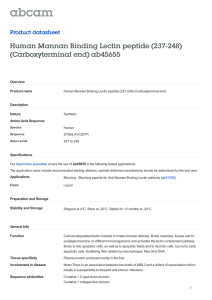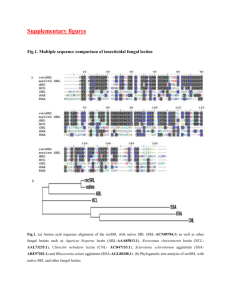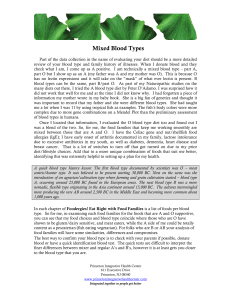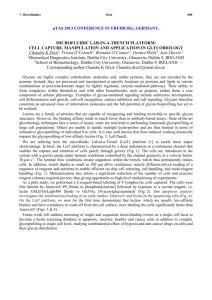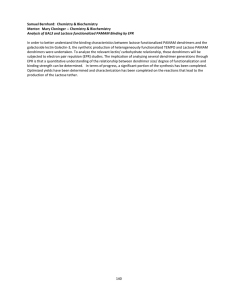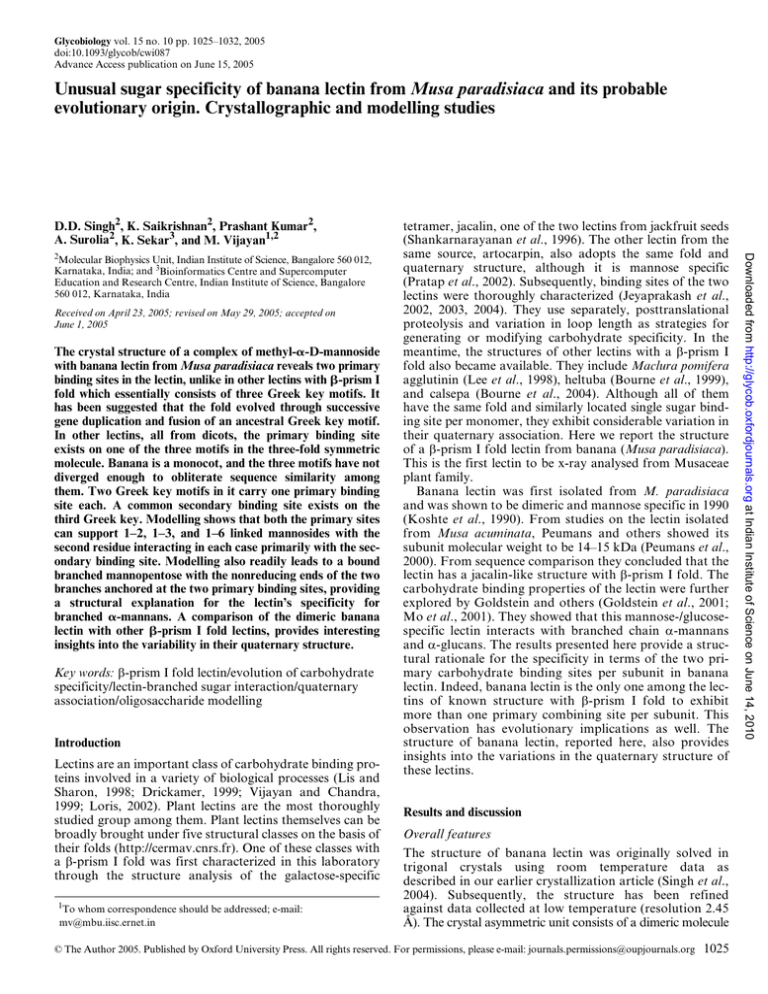
Glycobiology vol. 15 no. 10 pp. 1025–1032, 2005
doi:10.1093/glycob/cwi087
Advance Access publication on June 15, 2005
Unusual sugar specificity of banana lectin from Musa paradisiaca and its probable
evolutionary origin. Crystallographic and modelling studies
D.D. Singh2, K. Saikrishnan2, Prashant Kumar2,
A. Surolia2, K. Sekar3, and M. Vijayan1,2
Received on April 23, 2005; revised on May 29, 2005; accepted on
June 1, 2005
The crystal structure of a complex of methyl-␣-D-mannoside
with banana lectin from Musa paradisiaca reveals two primary
binding sites in the lectin, unlike in other lectins with -prism I
fold which essentially consists of three Greek key motifs. It
has been suggested that the fold evolved through successive
gene duplication and fusion of an ancestral Greek key motif.
In other lectins, all from dicots, the primary binding site
exists on one of the three motifs in the three-fold symmetric
molecule. Banana is a monocot, and the three motifs have not
diverged enough to obliterate sequence similarity among
them. Two Greek key motifs in it carry one primary binding
site each. A common secondary binding site exists on the
third Greek key. Modelling shows that both the primary sites
can support 1–2, 1–3, and 1–6 linked mannosides with the
second residue interacting in each case primarily with the secondary binding site. Modelling also readily leads to a bound
branched mannopentose with the nonreducing ends of the two
branches anchored at the two primary binding sites, providing
a structural explanation for the lectin’s specificity for
branched ␣-mannans. A comparison of the dimeric banana
lectin with other -prism I fold lectins, provides interesting
insights into the variability in their quaternary structure.
Key words: β-prism I fold lectin/evolution of carbohydrate
specificity/lectin-branched sugar interaction/quaternary
association/oligosaccharide modelling
Introduction
Lectins are an important class of carbohydrate binding proteins involved in a variety of biological processes (Lis and
Sharon, 1998; Drickamer, 1999; Vijayan and Chandra,
1999; Loris, 2002). Plant lectins are the most thoroughly
studied group among them. Plant lectins themselves can be
broadly brought under five structural classes on the basis of
their folds (http://cermav.cnrs.fr). One of these classes with
a β-prism I fold was first characterized in this laboratory
through the structure analysis of the galactose-specific
1
To whom correspondence should be addressed; e-mail:
mv@mbu.iisc.ernet.in
Results and discussion
Overall features
The structure of banana lectin was originally solved in
trigonal crystals using room temperature data as
described in our earlier crystallization article (Singh et al.,
2004). Subsequently, the structure has been refined
against data collected at low temperature (resolution 2.45
Å). The crystal asymmetric unit consists of a dimeric molecule
© The Author 2005. Published by Oxford University Press. All rights reserved. For permissions, please e-mail: journals.permissions@oupjournals.org
1025
Downloaded from http://glycob.oxfordjournals.org at Indian Institute of Science on June 14, 2010
2
Molecular Biophysics Unit, Indian Institute of Science, Bangalore 560 012,
Karnataka, India; and 3Bioinformatics Centre and Supercomputer
Education and Research Centre, Indian Institute of Science, Bangalore
560 012, Karnataka, India
tetramer, jacalin, one of the two lectins from jackfruit seeds
(Shankarnarayanan et al., 1996). The other lectin from the
same source, artocarpin, also adopts the same fold and
quaternary structure, although it is mannose specific
(Pratap et al., 2002). Subsequently, binding sites of the two
lectins were thoroughly characterized (Jeyaprakash et al.,
2002, 2003, 2004). They use separately, posttranslational
proteolysis and variation in loop length as strategies for
generating or modifying carbohydrate specificity. In the
meantime, the structures of other lectins with a β-prism I
fold also became available. They include Maclura pomifera
agglutinin (Lee et al., 1998), heltuba (Bourne et al., 1999),
and calsepa (Bourne et al., 2004). Although all of them
have the same fold and similarly located single sugar binding site per monomer, they exhibit considerable variation in
their quaternary association. Here we report the structure
of a β-prism I fold lectin from banana (Musa paradisiaca).
This is the first lectin to be x-ray analysed from Musaceae
plant family.
Banana lectin was first isolated from M. paradisiaca
and was shown to be dimeric and mannose specific in 1990
(Koshte et al., 1990). From studies on the lectin isolated
from Musa acuminata, Peumans and others showed its
subunit molecular weight to be 14–15 kDa (Peumans et al.,
2000). From sequence comparison they concluded that the
lectin has a jacalin-like structure with β-prism I fold. The
carbohydrate binding properties of the lectin were further
explored by Goldstein and others (Goldstein et al., 2001;
Mo et al., 2001). They showed that this mannose-/glucosespecific lectin interacts with branched chain α-mannans
and α-glucans. The results presented here provide a structural rationale for the specificity in terms of the two primary carbohydrate binding sites per subunit in banana
lectin. Indeed, banana lectin is the only one among the lectins of known structure with β-prism I fold to exhibit
more than one primary combining site per subunit. This
observation has evolutionary implications as well. The
structure of banana lectin, reported here, also provides
insights into the variations in the quaternary structure of
these lectins.
D.D. Singh et al.
Fig. 1. (a) Schematic representation of the lectin fold (b) The structure of
the banana lectin dimer viewed perpendicular to the molecular dyad.
Bound sugar molecules (PI, PII, and PIII) are also indicated.
1026
Structural variability and different modes of quaternary
association
The crystal structures of three other mannose-specific β-prism
I fold lectins, namely, artocarpin, heltuba, and calsepa, are
currently available. Artocarpin is a tetramer, whereas heltuba is an octamer. Calsepa, like banana lectin, is a dimer.
The sequence identity of banana lectin with the other three
lectins, computed using a structure-based alignment, varies
between 32 and 34%. The subunits of banana lectin superpose on those of the other lectins with rms deviations in the
Cα positions in the range of 1.14–1.31 Å. Thus the subunit
structures of the four lectins are essentially the same. Differences, however, occur in the loops. There is one major
difference involving strands as well. As shown below, this
difference is related to the quaternary association in the
four lectins.
As illustrated in Figure 2, artocarpin is a tetramer with 222
symmetry, whereas heltuba is an octamer with 422 symmetry. The artocarpin tetramer has two significant inter-subunit
interfaces: that between A and B and its symmetry equivalent
and that between A and C and its symmetry equivalent. Heltuba also has sets of two interfaces: 1–2 and 1–3. The intersubunit interface in dimeric banana lectin is similar to the AB
interface in artocarpin and 1–2 in heltuba. The dimeric interface in calsepa has some similarity with the 1–3 interface in
heltuba. If subunit 1 of heltuba and 1 of calsepa are superposed, the second subunit of calsepa can be brought into
superposition on the subunit 3 of heltuba by a rotation of
113° about an axis roughly perpendicular to the molecular
dyad of calsepa. Thus although the residues involved in the
dimeric interface of calsepa and the 1–3 interface of heltuba
have a great deal of commonality, the mutual orientation of
the subunits about the interface is dissimilar.
Fig. 2. Quaternary association in (a) artocarpin, (b) heltuba, (c) banana
lectin, and (d) calsepa.
Downloaded from http://glycob.oxfordjournals.org at Indian Institute of Science on June 14, 2010
with noncrystallographic two-fold symmetry. The two
subunits superpose with an root mean square (rms) deviation
of 0.26 Å in Cα positions. Thus, the two subunits have
practically the same structure. Protein code AAM48480
against banana lectin in NCBI database (http://www.ncbi.
nlm.nih.gov/entrez/) was used for model building. As in
the case of other jacalin-like lectins, the 141 residue
polypeptide chain in each subunit has a β-prism I fold in
which the Greek keys roughly form the faces of a trigonal
prism in such a way that the strands are parallel to the
approximate three-fold axis of the prism (Figure 1). The
polypeptide chain has a circular arrangement such that
the C-terminal residues 120–141 and 5–20 (residues 1–4
are not defined in the structure) form Greek key I. Greek
keys II and III are made up of residues 25–66 and residues
73–115 respectively. The loops in the Greek keys and
those that connect them occur at the two ends of the
prism. The carbohydrate binding sites are located at one
of these ends.
Evolution of sugar specificity of banana lectin
Sugar binding sites and evolutionary implications
Two bound methyl-α-D-mannoside molecules could be
clearly identified in each of the subunits (Figures 1 and 4).
One more sugar molecule could be identified in one of the
subunits (Figure 1); however density for it does not exist at
the corresponding site in the other subunit. Thus, two sugar
sites per subunit consistently occur in both the subunits.
The third sugar associated with one of the subunits makes
Fig. 3. Superposition of the main chain traces of banana lectin,
artocarpin, heltuba, and calsepa.
only two hydrogen bonds with the lectin, O1 with Asn106
ND2, and O4 with His63 NE2, as against 7–8 hydrogen
bonds made by the other two sugars. Furthermore, the
region where the third sugar binds is not characterized by
normal features, such as cavity, associated with sugar binding sites in lectins. Thus, the binding of the third sugar
appears to be an artifact resulting from high ligand concentration in the crystallization solution. Therefore, only the
two sugar binding sites, which occur in both the subunits
are considered in further discussion.
A single sugar binding site per subunit exists in other
β-prism I fold lectins whose sugar complexes have been X-ray
analysed. Among the mannose binding lectins with this
fold, the combining site has been well characterized in artocarpin and heltuba. Using the sequence numbering in
banana lectin, this binding site is made up of loops 14–17,
129–133, and 83–86. The first two loops constitute the primary binding site for the monosaccharide, whereas loop
83–86, which is longer in artocarpin, is responsible for differences in the oligosaccharide specificity of artocarpin and
heltuba (Jeyaprakash et al., 2004). In banana lectin also,
residue regions 14–17 and 129–133 are involved in binding
methyl-α-D-mannoside (Figure 4, Table I) with interactions similar to those found in artocarpin and heltuba. The
corresponding loops in the second binding site are 57–61
and 34–38 (Figure 4, Table I). Surprisingly, the geometries
of the two binding sites and the nature of the interactions
with sugar at them are almost identical.
The above observation appeared intriguing to start with.
A close examination of the sequences of the concerned lectins
however yielded a plausible explanation for it. In Figure 5,
sequences corresponding to the three Greek keys in each of
the four lectins are aligned on the basis of structural superposition among them. In the case of jacalin, it has been suggested that the lectin could have evolved through gene
duplication and fusion from a common ancestral motif of
about 40-residue length (Shankarnaryanan et al., 1996).
This suggestion appears to hold good for other lectins with
β-prism I fold as well. Over a period of time, the sequences
of the stretches have diverged substantially. There are only
one and two residues common to all the three stretches in
artocarpin and calsepa, respectively. The number is four in
heltuba as well as in banana lectin. In artocarpin and
calsepa, the sequence identity between Greek keys I and II,
and II and III is low in the range of 2–4, whereas it is 9–11
in banana lectin and heltuba. The sequence identity
between I and III is high in all cases and varies between
6 and 10. It is interesting that the primary carbohydrate
binding site lies on Greek key I, whereas Greek key III carries
the secondary site which determines the specificity at the
oligosaccharide level in artocarpin and heltuba. The main
component of the primary binding site and the secondary
binding site reside at comparable regions in the sequences,
but they do not have identical residues in them.
The most interesting observation in relation to carbohydrate binding is the relation between Greek keys I and II in
banana lectin. The main carbohydrate binding stretch in
Greek key I has a sequence GDXXD where X is a hydrophobic residue. Significantly this sequence is reproduced in
the same position in Greek key II as well, only in banana
lectin. Gly 15 in Greek key I, which also interacts with the
1027
Downloaded from http://glycob.oxfordjournals.org at Indian Institute of Science on June 14, 2010
The N terminal strand is involved in interactions in all
the four different types of inter-subunit interfaces. A few
C terminal residues adjacent to this strand in Greek key I
occur in three of the four interfaces, the 1–3 interface in heltuba being the exception. Residues 110–118 involving an
outer strand of Greek key III occur only in the inter-subunit
interface in banana lectin and the AB interface in artocarpin and the 1–2 interface in heltuba. On the contrary,
the stretch 45–59 in Greek key II occurs in the interface in
calsepa and to some extent in the AC interface of artocarpin and the 1–3 interface of heltuba. It does not occur in
the inter-subunit interface in banana lectin. The same is
true about the 16–24 stretch.
To further explore the possible effects of quaternary
association on the tertiary structure, the subunits in
tetrameric artocarpin, octameric heltuba, and dimeric
calsepa were replaced by the banana lectin subunit. These
models may be referred to as banana on artocarpin, banana
on heltuba, and banana on calsepa respectively. Thus, for
example, in banana on artocarpin, the arrangement of subunits in the tetramer is the same as in artocarpin, but each
subunit was taken from the structure of banana lectin. Similarly, models of calsepa on the other three lectins, artocarpin on the other three lectins, and heltuba on the
remaining three lectins were also constructed. Steric clashes
in these models were then carefully examined, particularly
in the regions involving stretches 16–24, 45–59, and 110–
118, which occur in some interfaces but not in the others.
All of them are involved in steric clashes. Those involving
the 45–59 stretch are particularly extensive. This perhaps
explains the substantial structural variation in this region
among the four lectins (Figure 3).
D.D. Singh et al.
Table I. Hydrogen bonding between methyl-α-D-mannoside and banana
lectin at the two primary sites (PI and PII)
Sugar site
O3
O4
O5
O6
PI
G15 N
G15 N
D130 N
D130 N
D133 OD1
F131 N
F131 O
D133 OD2
PII
G60 N
D38 OD2
D35 N
G34 N
V36 N
V36 O
D38 OD1
In addition to residues indicated above, V86 makes a hydrophobic contact
with sugar at PI.
sugar at the primary site, also exists at an identical position
in Greek key II. Thus, unlike in the other lectins, banana
lectin has two identical primary binding sites, one situated
on Greek key I and the other on Greek key II. In the other
lectins, the second site disappeared primarily on account of
divergent evolution. In this context, it is interesting to note
that the banana plant is a monocot, whereas the other lectins are from dicots.
Unique oligosaccharide specificity of banana lectin
In artocarpin and heltuba, the primary binding site is
constituted by loops 14–17 and 129–133, and they bind
mannose in the same way. However their specificity for
dimannosides and higher oligosaccharides differ on
account of their differences in the length and composition
of the third loop (residues 83–86 in banana lectin) on Greek
key III, which constitute the secondary binding site in both
the lectins. As indicated earlier, banana lectin has two primary binding sites; one the same as that in the other two
lectins situated on Greek key I and the other made up of
loops 57–61 and 34–38 situated on Greek key II.
1028
Interactions of dimannosides with banana lectin were
modelled separately with nonreducing ends situated in each
of the two primary sites. In each case, the mannose residue
at the primary site was assumed to have the same interactions with the protein as observed in the crystal structure.
The sugars used were Man-α-12-Man, Man-α-13-Man, and
Man-α-16-Man. Their conformations can be described by
the following torsion angles: 1–2, 1–3 linkages, Φ = O5-C1O-Cx´; ψ = C1-O-Cx´-Cx´-1, where x = 2 and 3 respectively; 1–6 linkage: Φ = O5-C1-O-C6´; ψ = C1-O-C6´-C5´;
ω = O-C6´-C5´-C4.´
From a statistical analysis of conformations observed in
crystal structures, it has been shown that two conformers
can occur about the Man-α-12-Man linkage (conformer
1: Φ 62.2 ± 8.3°; ψ –175° ± 10.3°; conformer 2: Φ 71.9° ± 13.1°;
ψ–104.4° ± 15.4°), one about the Man-α-13-Man linkage
(Φ 72.5° ± 11°; ψ –112.3° ± 22.5°) and three about the Manα-16-Man linkage. (conformer 1: Φ 65.4° ± 9.0°; ψ 182.6°
±22.5°; ω 66.4° ± 10.2°; conformer 2: Φ 66.5° ±10.8°;
ψ 180.7° ± 15.1°; ω 185° ± 11.2°; conformer 3: Φ 67.4° ± 14.4°;
ψ 109.1° ± 13.7°; ω 203° ± 22.7°) (Petrescu et al., 1999). All
the possible conformers were used in modelling with the
nonreducing mannose at primary site I as well as primary
site II. None of them led to any serious steric clash with the
protein. The interactions of the second sugar residue in the
energy-minimized models are listed in Table II. All of them
exhibit additional interactions involving the second sugar
residue, in consonance with the experimental results indicating that, unlike in the case of artocarpin and heltuba,
banana lectin binds the three dimannosides equally.
All the models except one interact with loop 83–86, irrespective of whether the nonreducing mannose is at primary
site I or primary site II. Thus the two primary sites have a
common secondary site. A composite view of two typical
models, one using primary site I and the other primary site
II is shown in Figure 6. Although the secondary site is common to both, the disposition of the loop bearing the site is
not the same with respect to the two primary sites. Therefore, the sugar binding site as a whole is asymmetric. The
implication of this asymmetry becomes clear when the
Downloaded from http://glycob.oxfordjournals.org at Indian Institute of Science on June 14, 2010
Fig. 4. (a) The primary binding sites (PI and PII) and the common secondary binding loop (long loop) in banana lectin. See text for details.(b) Lectinsugar hydrogen bonds at PI and PII.
Evolution of sugar specificity of banana lectin
* *
*
6
*
ban_1 120 KISGFFGRGG-----DFIDAIGVYLE-----KVGAWGGNGGSAFDMGPA--Y--- 24
ban_2 25 RIISVKIFSG-----DVVDAVDVTFTYYGKTETRHFGGSGGTPHEIV-LQ-EGEY 72
ban_3 73 -LVGMKGEFGNYHGVVVVGKLGFSTNKK---SYGPFGNTGGTPFSLP-IAAG--- 119
* *
*
*
art_1 LIVGFKGRTG---------DLLDAIGIHM--S--TV-GSWGGP-G-G-NGWDEGSY-T--art_2 -GIRQIELSYKE-------AIGSFSVIYDLNGDPFS-GPKHTSKLPYKNVKIELKF-PDEF
art_3 -LESVSGYTGPFSALATPTPVVRSLTFKT--NKGRTFGPYGDE-E-G-TYFNLP-IENG—
* *
*
*
cal_1 NEIVGFLGRS---G-----YYVDAIGTYN-R----I-SGPWGN----NGGNFWSFRPV--Ncal_2 -KINQIVISYGGGG-----NNPIALTFSSTKADGSKDTITVGGGGPDSITGTEMVNIGTDEY
cal_3 --LTGISGTF---GIYLDNNVLRSITFTT-NLK--A-HGPYGQ----KVGTPFSSANV---*
*
Fig. 5. Alignment of Greek keys I, II, and III in artocarpin, heltuba, calsepa, and banana lectin. Residues common in I and II, I and III, and II and III are
in different shades of grey.
Table II. Interactions of the second sugar residue in the modelled dimannoside with banana lectin
Disaccharide
O1
O2
O3
O4
O5
O6
Man-α12-Man (conformer 1)
PI
PII
D130 OD1
Y83 OH
Man-α12-Man (conformer 2)
PI
PII
H84 O
D35 OD1 & OD2
Man-α13-Man
PI
D130 OD2
PII
D35 OD1 & OD2
Y83 OH
Man-α16-Man (conformer 1)
PI
H84 O
PII
Y83 OH
Man-α16-Man (conformer 2)
PI
H84 O
PII
H84 ND1,
Y83 OH
Y83 OH
Man-α16-Man (conformer 3)
PI
D130 OD1
PII
D35 OD2
In addition, several van der Waals contacts with the 83–86 stretch also exist.
binding of higher oligosaccharides to the lectin is considered below.
The second sugar residue in none of the disaccharides
anchored at primary site I could be readily linked with that
of any of the disaccharides at primary site II, although they
interact with the same loop. An attempt was then made to
explore the possibility of a fifth sugar residue bridging the
two. In this exploration, a third residue was added using
α1–2, α1–3, and α1–6 linkages to the reducing mannose
residue in the disaccharide anchored at primary site I, to
start with. Here again two possible conformations were
used about the α1–2 linkage, one about the α1–3 linkage
and three about α1–6 linkage. Thus, there were altogether
mannotrioses with 36 distinct conformations anchored at
site I. The third residue in some of them came close to the
second residue of some of the disaccharides anchored at site
II. In a similar fashion models of trisaccharides with 36 distinct conformations anchored at site II were constructed. In
1029
Downloaded from http://glycob.oxfordjournals.org at Indian Institute of Science on June 14, 2010
* *
hel_1 KFAGFFGNSG-----DVLDSIGGVVV---DIAVQAGPWGGNGGKRWLQTAHGG
hel_2 KITSIIIKGG-----TCIFSIQFVYKDKDNIEYHSGKFGVLGDKAETITFAED
hel_3 - ITAISGTFGAYYHMTVVTSLTFQTN-----KKVYGPFGTVASSSFSLPLTK-
D.D. Singh et al.
PI
1
Manα
α
3
Manα
1
6
Manα
3
1
Fig. 7. Energy-minimized models of the branched pentasaccharide
complexed with banana lectin. See text for details.
binding site. The ease with which a branched oligosaccharide could be modelled into the carbohydrate binding
region of the lectin, as a direct consequence of the presence
of two nearly equivalent primary binding sites, readily
explains the unique specificity of banana lectin for
branched mannans. The branched oligomannosides which
have been shown to bind the lectin include the trisaccharide
Man α1,6 (Manα1,3) Man and the pentasaccharide found
in the core region of N-linked glycan chains (Mo et al.,
2001) as well as Man8,9 GlcNAcAc2 reported earlier
(Koshte et al., 1990). It is satisfying that all of them have
branching involving 3 and 6 positions as in the model.
Manα
6
PII
Manα
1
Scheme 1. Schematic representation of the modelled pentasaccharide.
no case did the third residue come close to the second residue
of any of the disaccharides anchored at site I in this case.
In two of the 36 trisaccharides anchored at site I, the
third residue was particularly close to the second residue in
the disaccharides anchored at site II. In both the cases, the
third residue of the trisaccharide and the second residue of
the disaccharide could be readily linked with minor changes
in the appropriate torsion angles leading to branched pentasaccharides schematically illustrated in Scheme 1. The
only difference between the two was in the conformation
about the 1–6 linkage between the second and third residue
starting from primary site I. However, the two converged to
essentially the same conformation after energy minimization. The energy-minimized pentasaccharide model along
with the binding regions of the lectin is shown in Figure 7.
In addition to the crystallographically defined interactions
at the primary sites involving the terminal residues, the other
three sugars also interact with Asp130, His84, and Tyr83.
Thus one readily obtains branched oligosaccharides of
mannoses with the nonreducing ends of the two branches
anchored at the two primary sites I and II. The residue at
the junction (bridging residue) and those adjacent to it on
either side interact primarily with the common secondary
1030
Materials and methods
Crystal structure determination
In our earlier communication, we reported the extraction,
purification, crystallization, data collection at room temperature (298 K) to 3 Å resolution and finally structure
solution using program PHASER, of banana lectin (Singh
et al., 2004). The structure was refined using CNS (Brunger
et al., 1998). In an effort to get better diffracting crystals,
5 mg/mL of protein and 100 mM of methyl-α-D-mannopyranoside solution in double distilled water was crystallized
using the sitting drop method. A typical drop contained
40 µl of the above protein–sugar solution and 2 µl of reservoir
buffer. It was equilibrated against 20 mL of the reservoir
buffer containing 0.01 M zinc acetate dihydrate, 0.1 M
sodium cacodylate pH 8.0, and 3 M 1,6-hexanediol. The
crystallization trays were stored at 298 K. Crystals of size
0.4 × 0.2 × 0.1 mm grew in a week’s time. The crystals
were directly flash cooled at 100 K in a stream of nitrogen
gas. Data were collected using a Mar research MAR 300
imaging plate mounted on a Rigaku RU-200 X-ray generator. The data were processed using the HKL package
(Otwinowski and Minor, 1997). Intensities were converted
to structure factors using TRUNCATE in Collaborative
Computational Project No. 4 (1994). Data collection statistics along with cell parameters are given in Table III.
Solvent content was estimated using the method of
Matthews (1968). The coordinates of the refined room temperature structure solved earlier were used for structure
solution using the program AMoRe (Navaza, 1994). The
structure was refined using CNS in the early stages and
Downloaded from http://glycob.oxfordjournals.org at Indian Institute of Science on June 14, 2010
Fig. 6. A composite view of the two typical models of disaccharide
complexed with banana lectin. Both have 1-6 linkages (Man- α16-Man
[conformer 2] in Table II). See text for details.
Evolution of sugar specificity of banana lectin
Table III. Data collection and refinement statistics
P3221
Space group
a (Å)
80.82
b (Å)
80.82
c (Å)
148.0
α (degree)
90.0
β (degree)
90.0
γ (degree)
120.0
Z
6
Resolution (Å)
2.45
Last shell (Å)
2.54–2.45
Number of observations
1,24,621
Number of unique reflections
21617 (2146)
Completeness (%)
99.0(99.3)
Protein data bank accession codes
Rmergea (%)
7.0(53.3)
Multiplicity
5.8
Protein atoms
2050
Sugar atoms
The atomic coordinates and the structure factors of the
complex were deposited in the RCSB Protein data bank
(PDB accession code 1X1V).
65
Water oxygen
498
R-factorb (%)
22.4
Rfreeb (%)
Resolution range (Å)
models. Molecular superpositions were performed using
the program ALIGN (Cohen, 1997). The dimannosides
were modelled using the program SWEET (Bohne et al.,
1998) and the molecular manipulation in the models was
done using INSIGHT II. Program NACCES was used for
calculating the accessible surface area (http://wolf.bms.
umist.ac.uk/naccess). X-PLOR (Brunger, 1992) was used
for energy minimization. Distance-dependent dielectric
constant was used throughout. During minimization, the
anomeric oxygens of the nonreducing mannose at primary
site were constrained. The observed lectin–sugar hydrogen
bonds and the different torsion angles in the modelled sugars were restrained with a force constant of 10 KCal/mol.
RIBBONS (Carson, 1997) and MolScript (Esnouf, 1997)
were used for generating figures.
Acknowledgements
26.0
24.92–2.45
RMS deviations from ideal value
Bond length (Å)
0.009
Bond angle (degree)
1.53
Residue (%) in Ramachandran plot
Core region
83.4
Additionally allowed region
15.1
Generously allowed region
1.5
Disallowed region
0.0
Values within parentheses refer to the last resolution shell.
a
Rmerge = ∑|Ii − <I>| /<I>.
b
R = ∑||Fo| − |Fc|| / ∑|Fo|; Rfree is calculated in the same way but for a subset of reflections Rfree that is not used in the refinement.
refinement was completed using the program REFMAC in
Collaborative Computational Project No. 4 to a final R
value of 22.4 and R free value of 26.0%. The final model
had clear density for residues 4–141 in the first subunit, 2–
141 in the second subunit, 498 water molecules, 3 zinc
atoms, 6 molecules of 1,6-hexanediol which was present in
the crystallization buffer. Clear densities for methyl-α-Dmannopyranoside were located at two different sites in
both the subunits. A third sugar binding site was also
located in the first subunit alone.
Analysis and modelling
Hydrogen bonds in the crystal structure were identified
using the program hbplus (McDonald and Thornton,
1994). CONTACT in Collaborative Computational Project
No. 4 was used for calculating nonbonded distances in
X-ray data were collected at the X-ray Facility for Structural Biology supported by the Department of Science &
Technology (DST) and the Department of Biotechnology
(DBT). Computations were performed at the Supercomputer Education and Research Centre, and the DBT-supported Bioinformatics Centre and Graphics Facility.
Financial support from DST is acknowledged. M.V. is supported by a DBT Distinguished Biotechnologist Award.
D.D.S. is a DBT post doctoral fellow.
Note added in proof
The following paper [Meagher, J.L., Winter, H.C., Ezell, P.,
Goldstein, I.J., and Stuckey, J.A. (2005) Crystal structure
of banana lectin reveals a novel second sugar binding site.
Glycobiology, 15, 1033–1042] describes the structure of banana
lectin from a different species. The structure reported by us
and that reported by Meagher et al. lead to the same basic
results. Their results additionally indicate the preference of
the primary binding sites for the reducing ends of the disaccharides used for complexation. Through modelling studies
we have provided a rationale for the affinity of the protein
for branched mannans. We have also dealt with the evolutionary origin of the two binding sites in the lectin.
References
Bohne, A., Lang, E., and Lieth, C.W.V. (1998) W3-SWEET: carbohydrate
modelling by internet. J. Mol. Model, 4, 33–43.
Bourne, Y., Roig-Zamboni, V., Barre, A., Peumans, W.J., Astoul, C.H.,
Van Damme, E.J., and Rouge, P. (2004) The crystal structure of the
Calystegia sepium agglutinin reveals a novel quaternary arrangement
of lectin subunits with a β-prism fold. J. Biol. Chem., 279, 527–533.
Bourne, Y., Zamboni, V., Barre, A., Peumans, W.J., Van Damme,
E.J.M., and Rouge, P. (1999) Helianthus tuberosus lectin reveals a
widespread scaffold for mannose-binding lectins. Structure Fold Des.,
7, 1473–1482.
1031
D.D. Singh et al.
1032
of Maclura pomifera agglutinin and the T-antigen disaccharide, Galβ1,3-GalNAc. J. Biol. Chem., 273, 6312–6318.
Lis, H. and Sharon, N. (1998) Lectins: carbohydrate specific proteins that
mediate cellular recognition. Chem. Rev., 98, 637–664.
Loris, R. (2002) Principles of structures of animal and plant lectins.
Biochim. Biophys. Acta, 1572, 198–208.
Matthews, B.W. (1968) Solvent content of protein crystals. J. Mol. Biol.,
33, 491–497.
McDonald, I.K. and Thornton, J.M. (1994) Satisfying hydrogen bonding
potential in proteins. J. Mol. Biol., 238, 777–793.
Mo, H., Winter, H.C., Van Damme, E.J., Peumans, W.J., Misaki, A., and
Goldstein, I.J. (2001) Carbohydrate binding properties of banana
(Musa acuminata) lectin I. Novel recognition of internal alpha1,3linked glucosyl residues. Eur. J. Biochem., 268, 2609–2615.
Navaza, J. (1994) AMoRe: an automated package for molecular replacement. Acta Crystallogr., Sect. A, 50, 445–449.
Otwinowski, Z. and Minor, W. (1997) Processing of X-ray diffraction data
collected in oscillation mode. Methods Enzymol., 276, 307–326.
Petrescu, A.J., Petrescu, S.M., Dwek, R.A., and Wormald, M.R. (1999)
A statistical analysis of N and O-glycan linkage conformations from
crystallographic data. Glycobiology, 9, 343–352.
Peumans, W.J., Zhang, W., Barre, A., Houles Astoul, C., Balint-Kurti, P.J.,
Rovira, P., Rouge, P., May, G.D., Van Leuven, F., Truffa-Bachi, P.,
and Van Damme, E.J. (2000) Fruit-specific lectins from banana and
plantain. Planta, 211, 546–554.
Pratap, J.V., Jeyaprakash, A.A., Rani, P.G., Sekar, K., Surolia, A., and
Vijayan, M. (2002) Crystal structure of artocarpin, a Moraceae lectin
with mannose specificity, and its complex with methyl-α-D-mannose:
implications to the generation of carbohydrate specificity. J. Mol.
Biol., 317, 237–247.
Shankarnarayanan, R., Sekar, K., Banerjee, R., Sharma, V., Surolia, A.,
and Vijayan, M. (1996) A novel mode of carbohydrate recognition in
Jacalin, a Moraceae plant lectin with a β-prism fold. Nat. Struct. Biol.,
3, 596–603.
Singh, D.D., Saikrishnan, K., Kumar, P., Dauter, Z., Sekar, K., Surolia, A.,
and Vijayan, M. (2004) Purification, crystallization and preliminary
X-ray structure analysis of the banana lectin from Musa paradisiaca.
Acta. Crystallogr., Sect. D, 60, 2104–2106.
Vijayan, M. and Chandra, N. (1999) Lectins Curr. Opin. Struct. Biol., 9,
707–714.
Downloaded from http://glycob.oxfordjournals.org at Indian Institute of Science on June 14, 2010
Brunger, A.T. (1992) X-PLOR, Version, 3.1. A System for X-Ray Crystallography and NMR. Yale University Press, New Haven, CT.
Brunger, A.T., Adams, P.D., Clore, G.M., DeLano, W.L., Gros, P.,
Grosse-Kunstleve, R.W., Jiang J.S., Kuszewski, J., Nilges, M., Pannu,
N.S., and others. (1998) Crystallography and NMR system (CNS):
a new software system for macromolecular structure determination.
Acta Crystallogr., Sect. D., 54, 905–921.
Carson, M. (1997) Ribbons. Methods Enzymol., 277, 493.
Cohen, G.E. (1997) ALIGN: a program to superimpose protein coordinates, accounting for insertion and deletions. J. Appl. Crystallogr., 30,
1160–1161.
Collaborative Computational Project No. 4 (1994) The CCP4 suite: programs
for protein crystallography. Acta Crystallogr., Sect. D., 50, 760–763.
Drickamer, K. (1999) C-type lectin-like domains. Curr. Opin. Struct. Biol.,
9, 585–590.
Esnouf, R. (1997) An extensively modified version of MolScript that
includes greatly enhanced coloring capabilities. J. Mol. Graph Model,
15, 132–134.
Goldstein, I.J., Winter, H.C., Mo, H., Misaki, A., Van Damme, E.J., and
Peumans, W.J. (2001) Carbohydrate binding properties of banana
(Musa acuminata) lectin II. Binding of laminaribiose oligosaccharides and
beta-glucans containing beta 1,6-glucosyl end groups. Eur. J. Biochem.,
268, 2616–2619.
Jeyaprakash, A.A., Geetha Rani, P., Banuprakash Reddy, G., Banumathi, S.,
Betzel, C., Sekar, K., Surolia, A., and Vijayan, M. (2002) Crystal structure
of the jacalin-T-antigen complex and a comparative study of lectin-Tantigen complexes. J. Mol. Biol., 321, 637–645.
Jeyaprakash, A.A., Katiyar, S., Swaminathan, C.P., Sekar, K., Surolia, A.,
and Vijayan, M. (2003) Structural basis of the carbohydrate specificities of jacalin: an X-ray and modelling study. J. Mol. Biol., 332,
217–228.
Jeyaprakash, A.A., Srivastav, A., Surolia, A., and Vijayan, M. (2004)
Structural basis for the carbohydrate specificities of artocarpin: variation in the length of a loop as a strategy for generating ligand specificity. J. Mol. Biol., 338, 757–770.
Koshte, V.L., Dijk, W.V., Stelt, M.E.V.D., and Aalberse, R.C. (1990) Isolation and characterization of BanLec-I, a mannoside-binding lectin
from Musa paradisiac (banana). Biochem. J., 272, 721–726.
Lee, X., Thompson, A., Zhang, Z., Ton-that, H., Biesterfeldt, J., Ogata, C.,
Xu, L., Johnston, R.A., and Young, N.M. (1998) Structure of the complex

![Anti-Mannan Binding Lectin antibody [11C9] ab26277 Product datasheet 3 References Overview](http://s2.studylib.net/store/data/012493460_1-1e40b04ea9ecd86e8593f12d0a3e6434-300x300.png)
